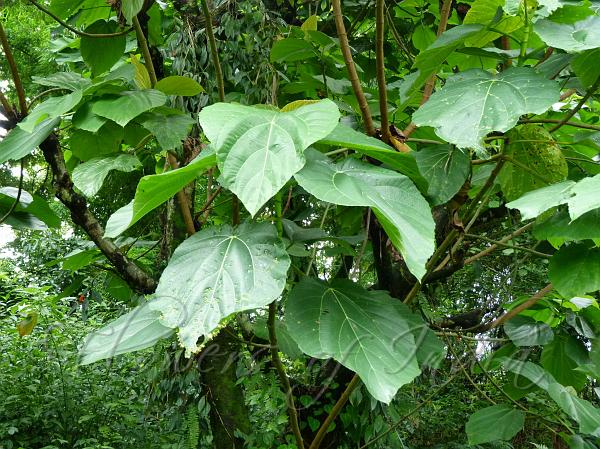|
| Elephant Ear Fig |
|

|

| File size | 869609 |
| Original date | 6/27/11 12:29 PM |
| Resolution | 2560 x 1920 |
| Flash | Flash did not fire, auto |
| Focal length | 12.1mm |
| Exposure time | 1/60s |
| Aperture | 3.3 |
| Focus Distance | |
| Metering Mode | Multi-segment |
| Camera make | Panasonic |
| Camera model | DMC-FZ40 |
| Sensor type | OneChipColorArea |
|
|
|
|
Photo: |
Botanical name: Ficus auriculata Family: Moraceae (Mulberry family)
Synonyms: Ficus oligodon, Ficus roxburghii, Ficus macrophylla Roxb. & Buch.-Ham. ex Sm.
Synonyms: Ficus oligodon, Ficus roxburghii, Ficus macrophylla Roxb. & Buch.-Ham. ex Sm.
Elephant Ear Fig a fig tree with very large
leaves, reminding one of elephant ears. The young leaves start
intensely red, and turn more and more green when reaching their
ultimate size of up to 50 cm length.
It is a tree 5-10 m tall, with crown wide, and a bole diameter of
10-15 cm. Bark is gray, smooth. Branchlets are sparsely pubescent.
Stipules, falling off soon, are ovate-lanceolate, 1-1.5 cm. Leaves are
alternately arranged, carried on 4-6 cm long stalks. They are
obovate-elliptic to elliptic, 12-25 × 6-23 cm, papery, densely small
tuberculate on the underside, hairless above, base shallowly
heart-shaped to broadly wedge-shaped, margin irregularly toothed. Figs
are clustered on short branchlets of old stems, sometimes even on the
roots of the tree. They are dark red when mature,
pear-shaped to spherical, with 4-6 longitudinal ridges and small
tubercles. They are large for figs, 2-3.5 cm in diameter, covered with
soft hairs. Figs are edible and sweet. In Meghalaya, fruits are eaten
raw, leaves are lopped for highly palatable fodder. Elephant Ear Fig
is found in the Himalayas, from Nepal to NE India, Burma, S. China,
Indo-China and Malaya, at altitudes of 1000-2100 m.
| Identification credit: Tabish | Photographed in Sikkim, Kalimpong & Manipur. |
• Is this flower misidentified? If yes,